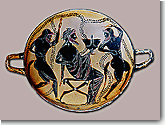






      |
|
| |
Our knowledge of the formation of Archaic society derives mainly from classical sources. What is clear in these is the existence of groups formed on a local or kinship basis: the tribes, |
 |
Two kinds of forms of social formation made their appearance: those based on kinship and those with place of residence as their principle. In both cases, the principle of heredity was in force. Thus even in the demes - the local institution par excellence - the status of the demotes was hereditary and did not disappear if the citizen relocated to another region. |
We cannot say with certainty exactly when these forms of organization made their appearance, but the tribes, at least, can very probably be attributed to the |
|
| |
|
Note: Click on a picture for a brief description. | |